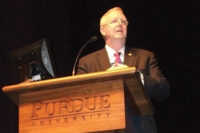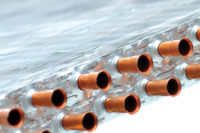It was a week of papers, presentations, plenary sessions, and lab tours for some 700 researchers and scientists, half of whom came from outside of the United States. Three concurrent conferences covered compressors, refrigeration, and natural working fluids.
Sessions started early in the morning and went late into the afternoon, followed by evening and social functions most every day.
The Lafayette area and Purdue are ideal to hold a midsummer’s conference. The area, which can handle huge Big Ten football crowds four or five times each fall, easily accommodates a mere handful of researchers.
There’s also an air of history here. The Tippecanoe memorial site recounts an 1811 battle of significance to the Midwest, and provides the gateway to the 13-mile Wabash Heritage Trail for hikers interested in a wooded trek along a creek and the Wabash River, into downtown Lafayette and West Lafayette.
Purdue boasts two 18-hole golf courses. One shows how education permeates all aspects of the campus. On two fairways, about 150 yards out, small sections were outlined in white powder and marked with small signs. It seems that tests were being conducted on what type of grass and grass mixtures would work best.
Another fairway borders a deep wood. A sign at just about the spot most hooked shots enter the woods, indicates that the wooded area is a forestry research lab — a subtle hint not to try to track down an inexpensive golf ball at the expense of some environmental project.
Over the last few weeks, The News has been providing reports from the conference, and the coverage wraps up in this week’s issue. But here is a passing thought:
There was an effort to continue to promote the long-term value of artificially made HFCs, with many papers focusing on ways to make those fairly new refrigerants more efficient and effective (see “Taking New Refrigerants to the Peak,” August 28, page 16). There wasn’t much pressure from Europe to phase out HFCs. But attention was paid to at least one alternative, the so-called natural refrigerant, CO2.
The Purdue conference is not designed to send signals to the industry. It exists to report on research being done on literally hundreds of areas of hvacr.
For contractors and technicians, such a conference serves an important purpose. You may have questions or concerns about new refrigerants, lubricants, and technologies. Right now, you may feel that you can’t get your questions answered; it could be that there are no answers — yet. But the Purdue conference demonstrates that there are a lot of people working on those answers.
Powell is refrigeration editor for The News. You may reach him at 847-622-7260; 847-622-7266 (fax); or PowellBNP@aol.com (e-mail).


